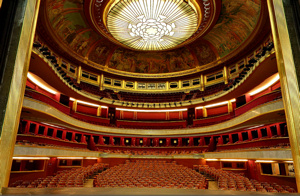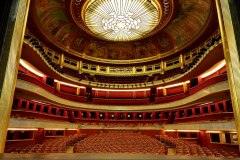Anna Vinnitskaya
March 2026 | ||||||
|---|---|---|---|---|---|---|
Mo | Tu | We | Th | Fr | Sa | Su |
Pianist Anna Vinnitskaya between Scriabin’s virtuosity and Ravel’s colors.
It is no exaggeration to say that the young Russian pianist Anna Vinnitskaya, who has been based in Germany for several years now, grew up in a world where music reigns supreme. Just consider: her grandfather was a conductor at the Odessa Opera, her parents are both pianists and piano teachers, her uncle Alexander Vinnitski, a student of Oistrakh, is a concert violinist and now teaches at the Helsinki Conservatory, and her brother is a percussionist... Winner of the First Prize at the Queen Elisabeth Competition in 2007, she enjoys a brilliant career as a recitalist, soloist, and teacher. For this second recital at the Théâtre des Champs-Elysées, she has chosen a repertoire she knows inside out. The evening begins with Ravel, Scriabin, then Brahms and Rachmaninov.
A new opportunity this evening to showcase the full range of her technical virtuosity and her sense of color.
Program and cast
Anna Vinnitskaya, piano
Programme
Ravel: Sonatine, Pavane for a Dead Princess, Jeux d’eau
Scriabin: Sonata No. 3, Op. 23
Brahms: Three Intermezzi, Op. 117
Rachmaninov: Variations on a Theme of Corelli, Op. 42
Théâtre des Champs-Élysées

The Théâtre des Champs- Elysées is undoubtedly one of the finest venues in Paris . Built in 1913 , it has the distinction of having been designed by a group of artists architects Henry Van de Velde and Auguste Perret , the painter and sculptor Antoine Bourdelle , the painter Maurice Denis , and the crystal- René Lalique to do mention the main ones . He was the first Parisian theater to be built entirely of reinforced concrete.
Restoration of the Great Hall devoted to operatic performances , symphony concerts and dance was decided in 1985. Two years later , on 23 September 1987, the theater reopened its doors , completely renovated. Fifteen years after this important work it was decided to undertake a new renovation campaign , but to prevent the complete closure of the theater for an entire season , work is now carried by step during the summer . Then it is to replace aging equipment , to remedy wear certain parts of the theater and improve spectator comfort and artists during their visit . Thus in recent years, including the work involved the renovation of marble facade, replacing the carpet in the room with wooden floors , installation of a new fully decorated wooden concert to a significant improvement of acoustics, the orchestra pit and stage below .
The Théâtre des Champs- Elysées is now a modern working tool receiving each year nearly 300,000 spectators and a few thousands of artists and collaborators.
The Théâtre des Champs- Elysées , the jewel of French architecture of the twentieth century, was in 1953 one of the first buildings of contemporary architectural heritage to be classified as historic monuments . Since 1970 the Caisse des Dépôts owns the entire building 15 avenue Montaigne and principal patron of the theater.
For over a century, Théâtre des Champs-Elysées has been the place where the most celebrated artists have come to make their names in Paris. The world’s finest orchestras and world-class soloists have always been a fixture at the Theatre. Théâtre des Champs-Elysées presents more than 200 concerts each year and is renowned for its outstanding performances of all genres, from classical music concerts and staged opera to contemporary dance and jazz.
How to reach us:
Subway: Alma-Marceau (line 9), Franklin D.Roosevelt (line 1), Pont de l’Alma (RER line C)
Bus: n° 42, 63, 72, 80, 92
Taxi station: Place de l’Alma, corner of avenue George V
Car park: Alma George V. The entrance is in front of n° 19, avenue George V
Fixed rate depending on the length of the performance. Payment upon entering.

 EN
EN DE
DE IT
IT FR
FR ES
ES RU
RU JP
JP RO
RO
 Seating plan
Seating plan 